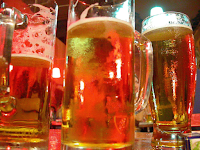Thank you to Lorine of
The Olive Tree Genealogy blog for writing about the FamilySearch record collection of
"Ontario, Roman Catholic Church Records, 1760-1923." It was a good reminder for me to take a look at these records for the only branch of my family tree that seems to have lived in Canada.
My Baker relatives lived in Seneca, Haldimand County, Ontario, from at least 1861 to 1866. The first child was born earlier than that, somewhere in Canada in 1853, but I haven't confirmed that it was in Seneca. I'm not sure why I never browsed these images before but, since the only towns listed under Haldimand are Caledonia, Cayuga, and Dunnville, I wasn't sure if I'd find anything.
I started with Caledonia and saw that one of the record collections for St. Patrick Parish fit the time period for my Bakers: "Baptisms, marriages, burials 1857-1898." On the fourth image, I found a match. Fantastic! Thomas Baker was the brother of my 2nd great-grandmother, Mary Baker. It confirms their parents' names (although I have Arthur instead of Arthurs), and it points me to another possible relative, Mary Arthurs.
 |
Baptismal Record for Thomas Baker, 1857
(CLICK TO VIEW LARGER) |
If I'm reading the writing correctly, the record says: "This eight day of October one thousand eight hundred and fifty seven I the undersigned priest have baptised Thomas - born since the first day of February from the lawful marriage of John Baker and of Elisabeth Arthurs of the township of Seneca of the Mission of Indiana, Sponsors were John Goslinn and Mary Arthurs."
This is the only family member I could find in any of the towns listed under Haldimand, but I'll take it. Thank you, Lorine!

















